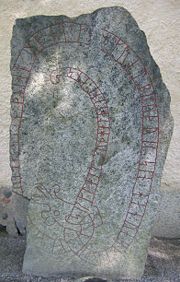
Tillinge Runestone
Encyclopedia

Rundata
The Scandinavian Runic-text Data Base is a project involving the creation and maintenance of a database of runic inscriptions. The project's goal is to comprehensively catalog runestones in a machine-readable way for future research...
, is a Viking Age
Viking Age
Viking Age is the term for the period in European history, especially Northern European and Scandinavian history, spanning the late 8th to 11th centuries. Scandinavian Vikings explored Europe by its oceans and rivers through trade and warfare. The Vikings also reached Iceland, Greenland,...
memorial runestone that was found at the church of Tillinge in Uppland
Uppland
Uppland is a historical province or landskap on the eastern coast of Sweden, just north of Stockholm, the capital. It borders Södermanland, Västmanland and Gästrikland. It is also bounded by lake Mälaren and the Baltic sea...
, Sweden
Sweden
Sweden , officially the Kingdom of Sweden , is a Nordic country on the Scandinavian Peninsula in Northern Europe. Sweden borders with Norway and Finland and is connected to Denmark by a bridge-tunnel across the Öresund....
.
Description
The Tillinge Runestone inscription consists of a runic text within a serpent. It was initially found within the church wall, but the full inscription could not be read until it was removed from the wall in 1946 and raised in front of the church. Many runestones were reused for materials in the construction of roads, bridges, walls, and buildings before their historical significance was understood. The inscription is dated as being from the first half of the 11th century and is in Old NorseOld Norse
Old Norse is a North Germanic language that was spoken by inhabitants of Scandinavia and inhabitants of their overseas settlements during the Viking Age, until about 1300....
and written using the younger futhark
Younger Futhark
The Younger Futhark, also called Scandinavian runes, is a runic alphabet, a reduced form of the Elder Futhark, consisting of only 16 characters, in use from ca. 800 CE...
.
The Tillinge Runestone was raised by a man in memory of his brother who died in Serkland
Serkland
In Old Norse sources, such as sagas and runestones, Særkland or Serkland was the name of the Abbasid Caliphate and probably some neighbouring Muslim regions....
, and ends in a prayer for the brother's soul. It may be one of the Ingvar Runestones
Ingvar Runestones
The Ingvar Runestones is the name of c. 26 Varangian Runestones that were raised in commemoration of those who died in the Swedish Viking expedition to the Caspian Sea of Ingvar the Far-Travelled....
, but is not included in that group as it does not mention Ingvar the Far-Travelled
Ingvar the Far-Travelled
Ingvar the Far-Travelled was the leader of an unsuccessful Viking attack against Persia, in 1036–1042.There were several Caspian expeditions of the Rus' in the course of the 10th century...
, the leader of a Swedish Viking expedition to the Caspian Sea
Caspian Sea
The Caspian Sea is the largest enclosed body of water on Earth by area, variously classed as the world's largest lake or a full-fledged sea. The sea has a surface area of and a volume of...
. As such, this runestone may be a memorial to a Varangian who died while in service in Asia.
The inscription is unsigned but has been attributed either to runemaster
Runemaster
A runemaster or runecarver is a specialist in making runestones.Most early medieval Scandinavians were probably literate in runes, and most people probably carved messages on pieces of bone and wood. However, it was difficult to make runestones, and in order to master it one also needed to be a...
s named Torbjörn or Gunnar. The inscription is classified as being carved in runestone style Pr1, which is also known as the Ringerike style
Ringerike style
The Ringerike style is a Scandinavian animal style from the late 10th century and the 11th century, which evolved out of the earlier Mammen style. It has received its name from a group of runestones with animal and plant motifs in the Ringerike district north of Oslo. The most common motifs are...
.
Inscription

Transliteration of the runes into Latin characters
- uifas-- ... : risa : s(t)in : þ(t)ino : ub : at : k-þmunt : bruþur : sin : han : uarþ : tuþr : a : srklant- kuþ halbi : ant : ans
Transcription into Old Norse
- Vifas[tr] [let] ræisa stæin þenna upp at G[u]ðmund, broður sinn. Hann varð dauðr a Særkland[i]. Guð hialpi and hans.
Translation in English
- Véfastr had this stone raised up in memory of Guðmundr, his brother. He died in Serkland. May God help his spirit.

